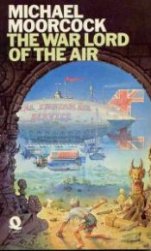
The War Lord of the Air
Michael Moorcock
156 pages
published in 1971
I read this book because of a discussion on rasfw about steampunk, where I mentioned this as an example. I had started to read it before on a trip to the UK, but hadn't finished it by the time I was back and had more or less forgotten about it.
The Warlord of the Air is written in what I call a mock-Victorean style, self- consciously imitating the way in which 19th century writers wrote. This is a style often used by writers of pastiche, like the various Holmes pastiches. In science fiction it's usually used in alternate history and (of course!) steampunk novels. (Actually, given the period in which this novel is set, it would be accurate to call it mock-Edwardian...)
In this case, it's used because supposedly this is not a novel written by Michael Moorcock, but a manuscript written by his grandfather, Michael Moorcock, who died in WW I and which tells of the allegedly true adventures of one Oswald Barnstable. Though since Moorcock had announced his own death in an introduction to one of his earlier novels, I took this with a grain of salt...
The first chapter tells how Moorcock found his grandfather's manuscript and how his grandfather met Barnstable. With the second chapter the real story begins, which starts when Oswald has to lead an expedition into the Indian mountain priestdom of Kumbalari, how he got lost in the Temple of the Future Buddha during an earthquakeand how he emerged from the year 1903 into the far flung future of 1973 --though not our 1973.
In this 1973, the airship rules supreme, world war I and subsequent events never happened and the world is still pretty much carved up between the various colonial powers: Britain, France, Russia and the US. Everything seems placid, everything seems okay and apart from a few lunatic anarchists and socilaists, nobody is unhappy. To Oswald it seems like utopia and he quickly adapts to the new world, becoming an officer aboard an airship.
Now if this was written by an US author, probably everything would've been as it seems at first. for some reason, American authors are very much attracted to visions of a stable, slightly stagnant but peaceful, extended victorean world. Take a look at A Transatlantic Tunnel, Hurray! for example, written at the same time.
In Moorcock's vision though, that stable, calm world has very much a dark side. Nor are those socialists and anarchist rebels quite as loony as they're first made out to be. I don't think it will come as a surprise that Oswald gets involved in their cause and so meets the Warlord of the Air, the first to use heavier then air machines.
I won't spoil what happens in the inevitable battle between the Warlord and the governments of the world, only to say that it's telegraphed quite a bit in advance. The story ends with Oswald being rescued off the coast of Japan, back in 1903, though perhaps not the same 1903...
As usual in an alternate history novel, there are some cute winks to real history and real people, for eample the lieutenant Jagger who accompanies Oswald on his trip back to England...
